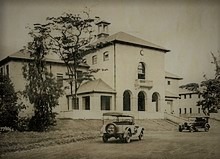The Nairobi School

As the British claimed regions of Kenya to settle into for posterity, the establishment of schools often reminiscent of their home, was top of mind. Schools that provided British curriculum learning for British students were essential in the expectations of the colony. Thus, the Prince of Wales School was born. We know it today as Nairobi School, one of Kenya’s coveted National Secondary Schools, but how did this institution come to be?
In many ways, the school was a response to necessity. The European School had been established in 1902 – a primary school that served the growing population of British residents. After several years of success, graduating primary students needed a secondary school to transfer into and so on 24th September 1929, then Governor of Kenya, Sir Edward Grigg, laid the foundation stone of what would become Kabete Boys Secondary School. It was envisioned as a magnificent institute, sitting on a sprawling 200-acre property that was designed by architect Herbert Baker who was instructed by Griggs that it should be reminiscent of his own school -Winchester. Of note, the structure of corridors and classes was built for purpose to allow for constant cooling given the heat of the East African climate which was significantly different from England. The school did not maintain its original name for long, as it was soon sought permission and was renamed in 1931 as the Prince of Wales School. Affectionally known as PoW by its early students it maintained a strict regimen suggestive of a naval academy stewarded by the first Headmaster Captain Nicholson. School days included corporal punishment, focused studies, and dedication to sports, while in time students transitioned from the initial grey to a navy blue uniform.

In 1962, with independence on the horizon, the school became multiracial and admitted its first African and Asian students, the first African Teacher – Mr. James Gitau followed in 1965 heralding a new era in the school’s history and the beginning of the true uhuru. It would be another decade before the first African headmaster D.M Muretihi was installed.
But back to 1965, when the school gained its third name – The Nairobi School. Almost ten years later, Kenyanization was the order of the day which meant that all public institutions, from roads to schools had to reflect the DNA of the Republic. As a result, the names of the houses within the school were Kenyanized. Clive House became Elgon, Hawke – Baringo, and Scott – Marsabit. Names that represented the breadth of Kenya and the national status that school now had. Around this period, the school also gained a new nickname – Patch. Alumni from the early times are members of the Old Cambrian Society, named in honor of Cambria, the Latin name of Wales. More recent school members alumni are known as Patcherians, a name which we hear came up in relation to either the method the School seamstress used to mend school uniforms (with a patch!) or the 1970 rock song by Clarence Carter called Patches.
Despite the many name changes throughout its history it has maintained in its school emblem its motto coined by the first headmaster “To the Uttermost” and the three ostrich feathers in a crown that has been a part of the Prince of Wales’s coat of arms since 1343. The Impala has been the undeniable symbol of Patch for 90 years, so ingrained that in an interesting twist a tree that grew outside the original gate developed its own impala head in one branch. Sadly the tree was lost in the recent expansion of Waiyaki Way.
Originally designed for just 80 students, on opening day in 1931 it had 104 boys. Of this number, 84 were boarders and 20 were day-scholars and new boarding blocks have been built constantly throughout its history to keep up with the demand for a spot in this emblematic Kenyan school. Today the Nairobi School is home to over 1100 students with students grateful to the vision that granted the campus its sprawling beautiful grounds so very long ago.
One question remains though – why is Patch called Patch? We’re hoping there are some old boys who can answer this elusive titbit of history!




6 Comments
Original source: A record by Clarence Carter, one side was ‘Patches’ and the flip side was ‘Changes’.
Later on, people used to say that if a Lenana student had torn clothes he changed them whilst Nairobi school students patched them
Thank you for this. We’ve heard it from a number of people and we’re starting to think that this is what coined the nicknames
I was placed in Scott House under Mr. Chadwick in 1960 and passed my School Certificate the following year. I performed so poorly at sports that I was put in the
“Slackers squad” which meant that before lessons I had to run around the Oval pursued by prefects armed with small branches of trees. Anyone who dared to stop was mercilessly assaulted by those licensed thugs until they rose to complete the circuit. Really my parents chose the wrong school for me, I had been happier at St. Mary’s School.
That is unfortunate. It is sad that corporal punishment can often go too far. Though we are glad to hear you made better memories at St. Mary’s.
Who was the first African student to be admitted at Prince Wales school in Nairobi in 1962?
Good question indeed! We do not have an answer to that question but we will let you know in the event that we come across that information